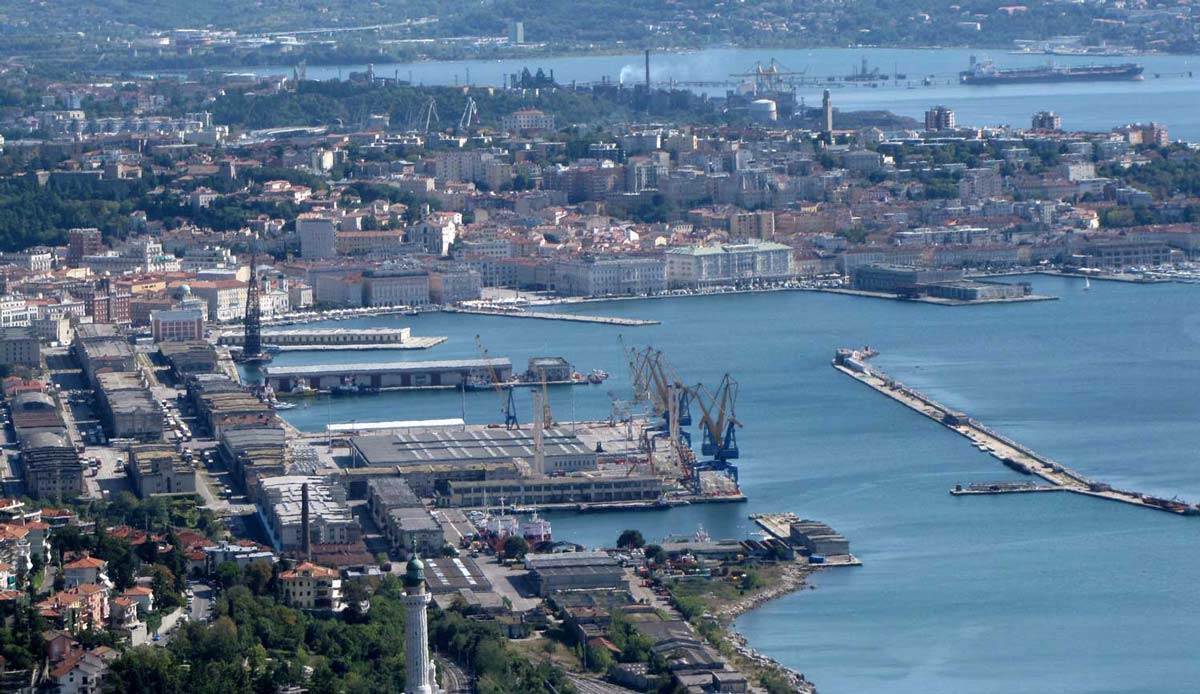Integrated Environmental Study and updating of the Port Planning Scheme
Client: Port Authority of Trieste
Period of implementation: 2010 – 2015
Total value of works: Euro 1.864.526.00,00
Value of our services: Euro 1.791.550,12
The increase in seagoing traffic and in trade between the Far East and Europe, as well as the enlarging of the European Union towards the east, have again highlighted the importance of the Upper Adriatic, thus opening extraordinary possibilities of growth and development for Trieste. In this context, the drawing up of the new Port Planning Scheme for the Port of Trieste, approved by the Higher Council of Public Works in 2010, was suitable and necessary in order to have an updated and agreed planning tool for the development of the port, and firmer indications on the possible locations of old and new activities.
The general aims of the Plan are the expansion of port areas, to overcome the shortage of dry port areas, the development of container traffic, to be more competitive and attractive with respect to the more dynamic market sectors, the improvement of the areas from former industrial sites and the development of the cruise sector.
The Trieste Port Planning Scheme has identified two basic scenarios (short and long term) regarding the construction of all the works planned; the works to be undertaken in the short term allow for response to immediately useful needs and priorities, in order to overcome the critical functional aspects, while the works to be undertaken in the long term are aimed at completing the Plan’s contents.
Under the procedure for environmental approval of the Trieste Port Planning Scheme, for the first time in Italy there is a combined Environmental Impact Assessment and Strategic Environmental Assessment procedure, given the need to implement in the shortest time possible the development of the Port, as specified in the plan, and avoid the lengthening of the time required for completing a series of regional and Cross-Border Strategic Environmental Assessments before (Legislative Decree 152/2006 and subsequent amendments and additions) and the National Environmental Impact Assessment after (Law 84/94). The combined Environmental Impact Assessment – Strategic Environmental Assessment procedure applied to the Port Planning Schemes (drawing up of documents, consultation procedures, expression of opinions) maintains the characteristic and most strict elements of each of the two procedures, introducing into the Environmental Impact Assessment procedures all the specific aspects of the Strategic Environmental Assessment (obligatory scoping stage; drawing up of a preliminary document, participation of parties having environmental competences in the definition of the information to be included in the final document; integration of strategic and planning contents, etc.). Therefore, according to the guidelines of the Ministry for the Environment and the Protection of the Territory and the Sea, an Integrated Environmental Study was commissioned.
The Integrated Environmental Study has identified, analyzed and quantified all the possible interactions between the Trieste Port Planning Scheme and the relative works for major infrastructures and the surrounding environment and territory, both during the construction and the operational phase. The estimate of the impact, and thus the definition of their significance, was made in relation to the quality of the environment in the current state and eventually with maximum reference thresholds, considering the effects induced by planning actions on the indicators identified as representing each environmental area. When possible, thanks to the use of modelling and numerical methods, the quality levels and critical aspects of the environment have been examined quantitatively, without the works (current condition or “zero option”) and with the works. The following components were examined: atmosphere, soil and subsoil, water environment (internal surface and groundwater), marine water environment, land vegetation, flora and fauna, landscape, noise, socio-economic aspects, traffic and waste.
Study of the atmosphere component
In order to assess the increase in the concentrations of the main pollutants emitted into the atmosphere (NOx, PM10 and SO2) due to the construction of the works contained in the Trieste Port Planning Scheme, in relation to the limits set by legislation, the following activities were conducted:
- Weather profiling and identification of the reference scenario (application of the AERMET sub-model);
- Identification of the emission sources (from land and sea traffic and from man-made activities);
- Modelling of existing sources;
- Application of sub-models for the estimate of the current and future emission rates (COPERT and MEET model);
- Application of the AERMOD dispersion model for calculating the amount of pollutants in the current condition and the operating condition (short-term and long-term scenario) and for the most representative construction phases;
- Evaluation of the effects produced by the actions of the Plan on the population and other sensitive factors.
- Study of the acoustic component
In order to assess the changes in environmental noise due to acoustic emissions from induced vehicle traffic and naval traffic, for both the construction and operational phase, the following activities were undertaken:
- profiling of the acoustic environment of the port area, also by the performance of specific sound level measurement);
- creation of an acoustic scenario of the current condition, adjusted on the basis of the sound level measurements performed;
- implementation of the current scenario, with the works and functions contained in the Plan (short-term and long-term scenario), and with regard to the specific port area and the related infrastructure area;
- evaluation of impact in residential and other sensitive points, in the port area itself and in an adequate area of the urban waterfront, with reference to the current acoustic classification in the municipality;
- identification of possible contingent factors and mitigation works required to contain the noise produced by the Plan actions.
Study of the landscape aspect
The perception analysis methodology was chosen to assess the impact on the landscape component deriving from the modifications resulting from the works in the Plan.
Perception analysis consists in the selection of a series of static observation points, called optical and/or visual cones, which provide a constant visual perspective of the areas involved by the most invasive works included in the Plan; the optical cones were selected in such a way that the views provided would represent ideal “territorial axes” providing visual contact between different sections of the territory. In order to assess the effects of the short- and long-term works in the Plan, there was photographic insertion on the basis of the optical cones identified.




